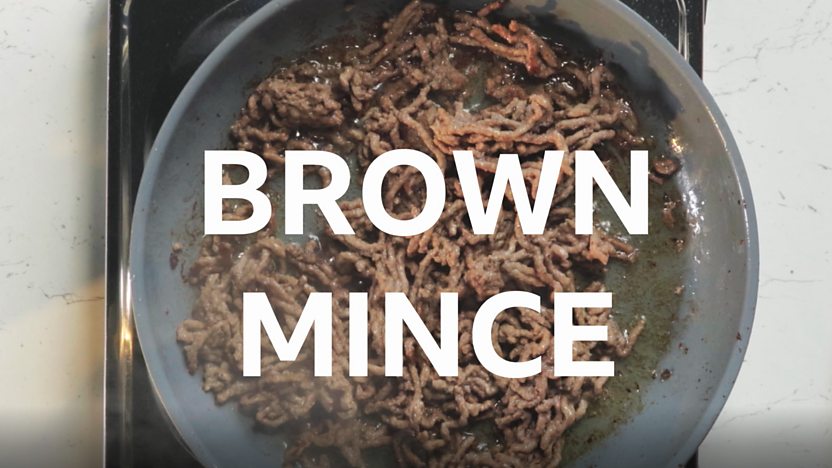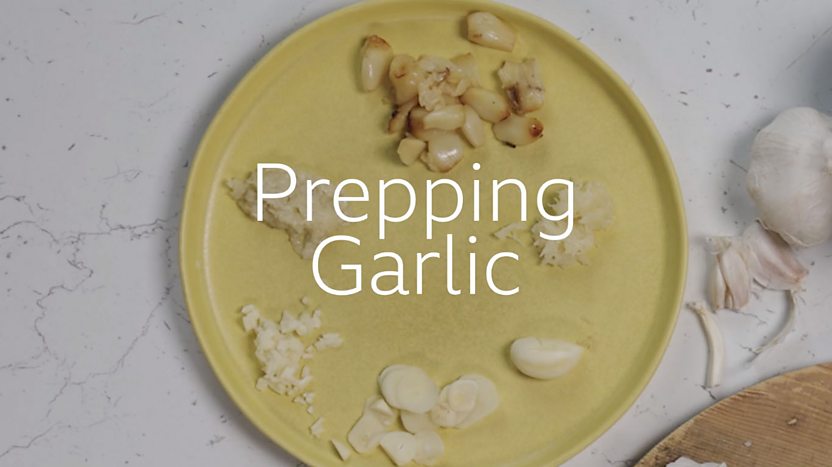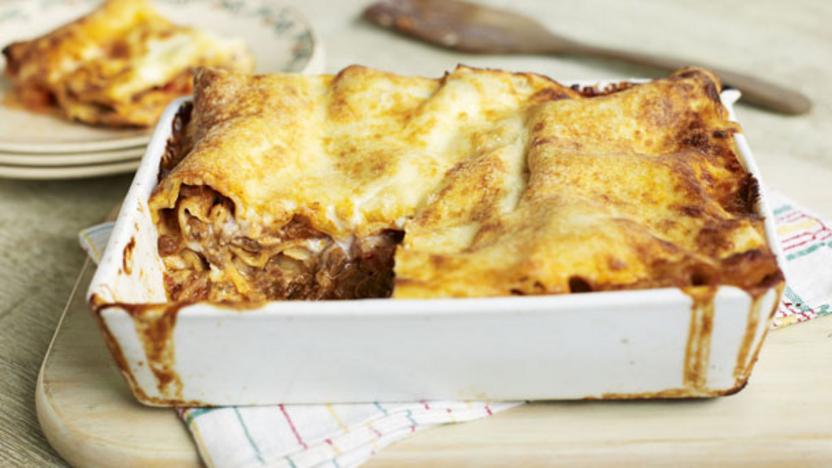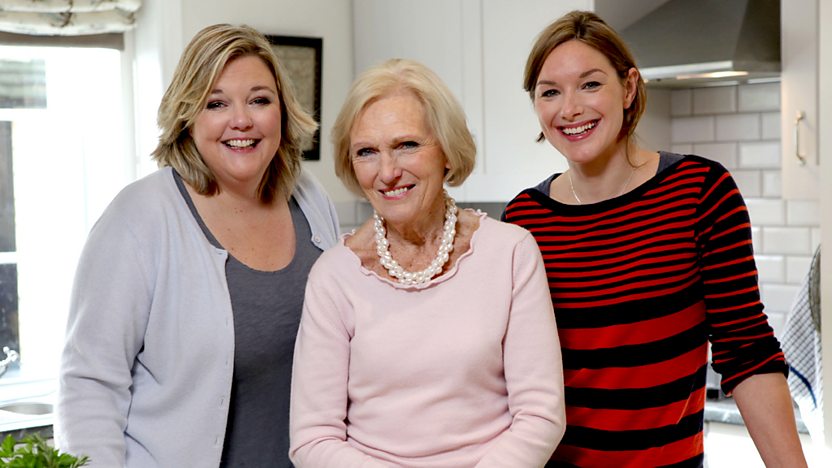Lasagne al forno
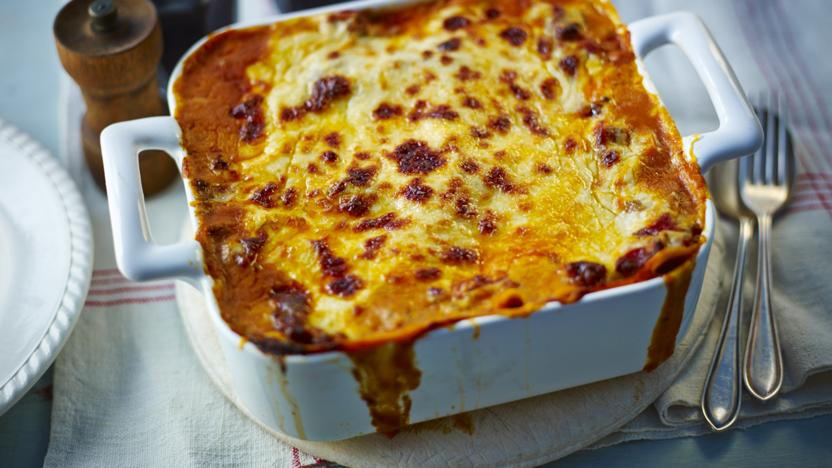
This is Mary's classic lasagne recipe which has been perfected over the years. For the best results leave the lasagne to stand for six hours before cooking.
Each serving provides 861 kcal, 50g protein, 56g carbohydrates (of which 17g sugars), 47g fat (of which 23g saturates), 5.5g fibre and 1.4g salt.

Ingredients
For the ragu
- 2 tbsp olive oil
- 900g/2lb beef mince
- 2 onions, roughly chopped
- 4 sticks celery, diced (optional)
- 2 garlic cloves, crushed
- 2 level tbsp plain flour
- 150ml/¼ pint beef stock
- 1 tbsp redcurrant jelly (optional) or 1 tsp caster sugar
- 3 tbsp tomato purée
- 1 tbsp chopped thyme
- 2 x 400g tins chopped tomatoes
For the white sauce
- 50g/2oz butter
- 50g/2oz plain flour
- 750ml/1¼ pints hot milk
- 2 tsp Dijon mustard
- 50g/2oz Parmesan, finely grated
- salt and freshly ground black pepper
For the lasagne
- 12 lasagne sheets
- 75g/3oz mature cheddar, grated
Method
Preheat the oven to160C/140C Fan/Gas 3.
For the ragu, heat a large frying pan until hot and add the oil. Cook the mince until browned all over. Remove from the heat and transfer to a plate.
Add the onion, celery (if using) and garlic to the pan and cook until softened. Return the meat to the pan and stir in the flour. Add the stock and bring to the boil. Add the redcurrant jelly (or sugar), tomato purée and thyme, then stir well.
Stir in the tinned tomatoes. Bring to the boil again, cover and simmer in the oven for 1–½ hours, or until the beef is tender.
For the white sauce, melt the butter in a saucepan. Add the flour and cook over the heat for one minute. Gradually whisk in the hot milk, whisking until thickened. Add the Dijon mustard and parmesan cheese and season well with salt and pepper.
For the lasagne, put one third of the meat sauce in the base of a 2.3 litre/4 pint shallow ovenproof dish. Spoon one third of the white sauce on top. Season with salt and pepper. Arrange one layer of lasagne sheets on top.
Spoon half of the remaining meat sauce on top and then half of the white sauce. Season with salt and pepper. Put another layer of lasagne sheets on top, then the remaining meat sauce and remaining white sauce. Sprinkle over the cheddar.
Leave for 6 hours before cooking so that the pasta can start to soften.
Preheat the oven to 200C/180C Fan/Gas 6.
Cook in the middle of the oven for about 45 minutes – or until golden brown on top, bubbling around the edges and the pasta is soft.
Recipe Tips
When Mary Berry first cooked this recipe on television in the 1970s, she used dripping to fry the meat and vegetables. Seek this out for a really meaty flavour, but olive oil is generally preferable now. You can also stretch this recipe out into two smaller lasagne, one for the freezer and one for now.
Do you cook pasta sheets before making lasagne?
Fresh pasta never needs to be precooked, but if you like a lot of pasta in your lasagne and are using dried pasta sheets you should consider it. It’s not necessary when making the recipe above, as the ratio of sauce to pasta, plus letting it stand for hours before cooking, means the pasta will be thoroughly cooked. If you are using a lower ratio of sauce to pasta and don’t have time to let it sit for hours before cooking, you might find the pasta is still chewy.
What order do you put lasagne layers in?
It depends how you like it. Recipes normally start with a layer of Bolognese, then white sauce and then pasta sheets – which is what Mary Berry has done in this recipe. Others add pasta between every layer (so Bolognese, pasta, white sauce, pasta, Bolognese etc). If you like a saucy lasagne, following the recipe above, but if you prefer yours with a bit more structure feel free to add extra layers of pasta.
However you like it, finish with a layer of bechamel (white sauce) before adding a final layer of cheese.
How many layers should a lasagne have?
However many you like! However, we think three is the minimum, with four to five optimal.
Do you put cheese on each layer of lasagne?
You can, but it’s not essential. If using, add a little cheese on top of each layer of white sauce (as Gennaro Contaldo does in his classic lasagne recipe).
Is it better to bake lasagne covered or uncovered?
It really depends how you like your lasagne. Covering the top with foil will keep moisture in, which helps the pasta to cook through and results in a soft, saucy lasagne. But if crispy edges are your thing then you are best leaving off the foil. Often the best way is to do a bit of both – cover with foil at first, then remove for the final 15 minutes to allow the top to crisp up.
How long should lasagne sit before slicing?
It’s best left to cool a little as this helps it firm up. Serving lasagne straight from the oven is a messy business! Letting it sit for half an hour will help keep the layers together so you can serve it in neat slices.
How far in advance can you make lasagne before cooking it?
You can assemble a lasagne up to 2 days in advance and keep it in the fridge until ready to cook. Alternatively, freeze your uncooked lasagne for up to 3 months.
If you don’t want your baking dish in the freezer for weeks on end, line your dish with baking paper or kitchen foil with enough overhang to cover the top before assembling the lasagne. Once the lasagne is assembled, cover the top with the overhang and freeze. Once it is frozen solid it will easily slip out of the dish. Wrap it again with cling film or foil and return to the freezer. When you are ready to cook it, remove the outer wrapping and pop it straight back into the dish. Frozen lasagne takes much longer to cook (around double the time), so cover the top with kitchen foil to prevent it frying out.
